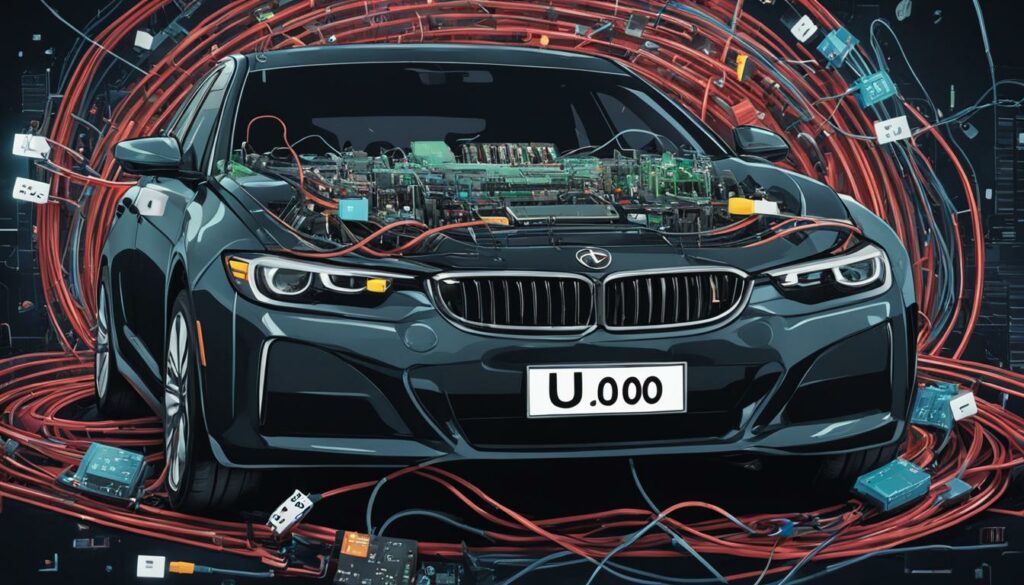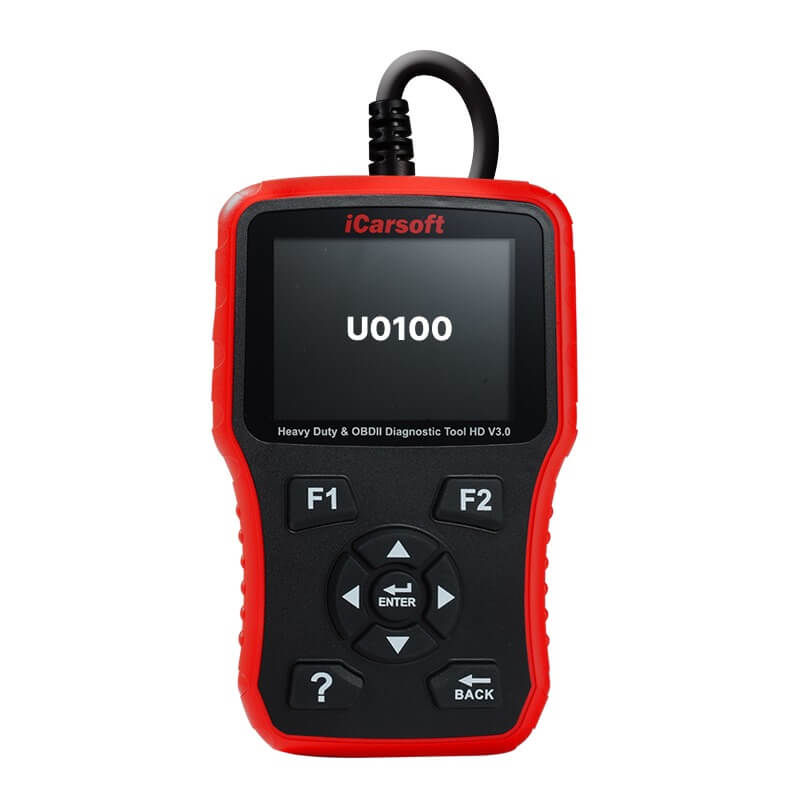U0100 – Lost Communication with ECM/PCM
POSTED IN pcodes
Welcome to our guide on the U0100 error code, which refers to a communication failure between the ECM/PCM (Engine Control Module/Powertrain Control Module) and another module in your vehicle. If you’re experiencing this error, it’s important to diagnose and resolve it promptly to prevent any further issues with your vehicle’s performance.
The U0100 code can be caused by various factors, including a malfunctioning PCM, a faulty control module circuit, or a fault in the data bus. Identifying the exact cause requires accurate diagnosis and troubleshooting techniques.
Key Takeaways:
- U0100 error code indicates a loss of communication between the ECM/PCM and another module in the vehicle.
- The most common symptom is an illuminated check engine light, but other symptoms may include a no crank or a click of the starter solenoid.
- Possible causes include a malfunctioning PCM, a faulty control module circuit, or a data bus fault.
- Accurate diagnosis often requires the use of specialized tools and professional assistance.
- Fixing the U0100 code depends on the specific make and model of your vehicle, and it may involve programming the ECM.
What Does the U0100 Code Mean?
The U0100 code, also known as “Lost Communication with ECM/PCM ‘A'”, is triggered when there is a loss of communication between the PCM (Powertrain Control Module) and a specific module in the vehicle. This loss of communication can result in the vehicle shutting off and not restarting until the issue triggering the code is addressed. The exact definition of the U0100 code may vary depending on the vehicle manufacturer.

When the U0100 code is present, it indicates a communication failure between the PCM, which controls the engine and transmission, and another module in the vehicle. This communication loss can occur due to various reasons, such as a malfunctioning PCM, a faulty control module circuit, or a fault in the data bus.
Buy tested tuning file for Adblue / EGR / DPF / Adblue off now!
The U0100 code is an important diagnostic code that requires attention as it can lead to performance issues and unreliable operation of the vehicle. To diagnose and resolve the U0100 code, it is crucial to understand its meaning and the potential causes behind it.
Possible Causes of the U0100 Code
When encountering the U0100 code, there are several potential causes to investigate. These include:
- Malfunctioning PCM: The Powertrain Control Module (PCM) is responsible for controlling various functions within the vehicle. If the PCM is not functioning properly, it can lead to a loss of communication with other modules, resulting in the U0100 code.
- Faulty control module circuit: A faulty circuit within a specific control module can disrupt communication with the PCM, triggering the U0100 code. It is important to identify and address any faults in the control module circuit.
- Data bus fault: The data bus is the pathway through which information is transmitted between modules in the vehicle. If there is a fault or disruption in the data bus, it can cause a loss of communication between the PCM and other modules, resulting in the U0100 code.
These possible causes should be thoroughly examined and diagnosed to pinpoint the exact issue leading to the U0100 code. By addressing these causes, it is possible to resolve the communication loss and restore optimal performance.
Common Symptoms of the U0100 Code
When encountering the U0100 code, there are several common symptoms that vehicle owners may experience. It’s important to be aware of these symptoms as they can indicate a potential issue with the vehicle’s communication systems.
- Check Engine Light: One of the most noticeable symptoms of the U0100 code is an illuminated check engine light on the dashboard. This warning light serves as an indicator that there is a problem with the vehicle’s powertrain control module (PCM) communication.
- No Crank: Another symptom that may occur is the vehicle failing to crank. This means that when the key is turned in the ignition, the engine does not start. The U0100 code can disrupt the proper communication between the PCM and other modules, leading to this issue.
- No Starter Solenoid Click: In some cases, when attempting to start the vehicle, there may be no audible click from the starter solenoid. This lack of click indicates a problem with the communication between the PCM and the starter solenoid, which is responsible for initiating the starting process.
- Service Messages on the Dash: The vehicle’s dashboard may display service messages that falsely indicate issues in various systems, such as “Service Power Steering” or “Fuel Low.” These messages can appear due to the U0100 code disrupting the communication between the PCM and other modules responsible for generating these notifications.
Being aware of these symptoms can help vehicle owners identify potential problems and take appropriate action to resolve the U0100 code.

Diagnosing the U0100 Code
Diagnosing the U0100 code can be a complex process. It requires the use of special procedures and diagnostic tools, such as an automotive oscilloscope, to pinpoint the module that is not communicating and identify the specific part of the communication bus where the problem lies.
An automotive oscilloscope is a powerful diagnostic tool that allows technicians to visualize and analyze electrical signals in real-time. By connecting the oscilloscope to the relevant modules and monitoring the communication signals, technicians can determine if there is a loss of communication and where it is occurring.
Pinpointing the communication loss is crucial for effectively troubleshooting the U0100 code. It helps identify whether the issue is with the PCM, the control module circuit, or the data bus itself. Once the specific module and communication segment are identified, further diagnostic tests can be carried out to narrow down the root cause of the communication failure.
Given the complexity of diagnosing the U0100 code, it is highly recommended to seek the assistance of a professional automotive technician who has experience with troubleshooting communication issues. They have the expertise and specialized equipment to diagnose and fix the problem accurately, minimizing the risk of misdiagnosis or unnecessary component replacements.
Remember, proper diagnosis and troubleshooting of the U0100 code is crucial for resolving the underlying communication issue and preventing potential performance issues in the vehicle.
How to Fix the U0100 Code
Fixing the U0100 code will depend on the specific make and model of the vehicle. There is no universal fix for the code, and it is best to consult the vehicle’s manual or seek professional assistance. If you are confident in your DIY auto repair skills, you can use online repair resources and guides to determine the appropriate solution for your vehicle. However, it is important to note that fixing the U0100 code may involve programming the ECM (Engine Control Module) and should be done with caution.
Vehicle-Specific Repair Steps
When faced with the U0100 code, it’s crucial to refer to the vehicle’s manual for specific repair steps. Each make and model may require different procedures and components to address the communication loss between the PCM and module. In the manual, you’ll find detailed instructions on how to safely diagnose and troubleshoot the U0100 code.
Professional Assistance
Resolving the U0100 code can be a complex task. If you’re uncertain about your repair skills or lack access to the necessary tools and equipment, it’s advisable to seek professional assistance. Automotive technicians have the expertise and experience to diagnose the issue accurately and perform the appropriate repairs. They will ensure that the ECM is properly programmed and all necessary components are repaired or replaced.
Online Repair Resources
If you’re comfortable tackling the U0100 code on your own, there are online repair resources available that provide comprehensive guides and step-by-step instructions for various vehicle models. These resources can be valuable references, offering detailed explanations and visual aids to help you understand the repair process. However, always exercise caution and verify the credibility and accuracy of the information before proceeding with any repairs.
Checking the Vehicle Manual
Before attempting any repairs, it’s essential to consult the vehicle manual. The manual contains crucial information about the specific components and systems of your vehicle. It will guide you through the recommended repair procedures and any precautions that need to be taken. By carefully following the manual’s instructions, you can ensure the U0100 code is properly addressed and prevent any further complications.
| Pros | Cons |
|---|---|
| Access to specific repair steps | Requires caution and proper programming |
| Professional expertise and accurate diagnosis | Cost of professional assistance |
| Online resources for DIY repairs | May require additional tools and equipment |
| Vehicle manual as a comprehensive guide | References should be verified for accuracy |
As seen in the table above, there are different approaches to resolving the U0100 code, each with its own advantages and considerations. Your choice may depend on your level of expertise, access to resources, and comfort with DIY repairs. Remember, if in doubt, it’s always best to seek professional assistance to ensure the U0100 code is resolved correctly.
Conclusion
The U0100 code is a serious issue that should not be ignored. Addressing the U0100 code promptly is of utmost importance to avoid potential risks and further complications with your vehicle’s performance. Ignoring this code can lead to the vehicle stalling and not restarting, which can be a major inconvenience.
To effectively resolve the U0100 code, it is recommended to seek professional assistance for accurate diagnosis and repair. A qualified technician will have the knowledge and tools to pinpoint the exact cause of the communication failure between the PCM and the module in your vehicle. They can provide the necessary solutions to fix the issue and restore the proper functionality of your vehicle.
If professional assistance is not available, alternative solutions may be possible to permanently remove the U0100 code. However, it is important to note that these solutions may not address the underlying problem and may have potential implications for the vehicle’s performance and safety.
Overall, do not underestimate the significance of the U0100 code. Taking immediate action to diagnose and fix this issue is crucial to ensure the continued smooth operation of your vehicle and to mitigate any potential risks associated with ignoring the U0100 code.
FAQ
What does the U0100 code mean?
The U0100 code signifies a loss of communication between the PCM (Powertrain Control Module) and a specific module in the vehicle.
What are the possible causes of the U0100 code?
The U0100 code can be caused by a malfunctioning PCM, a faulty control module circuit, or a fault in the data bus.
What are the common symptoms of the U0100 code?
The most common symptom of the U0100 code is an illuminated check engine light. Other symptoms may include the vehicle not cranking or the starter solenoid not clicking.
How is the U0100 code diagnosed?
The U0100 code is diagnosed using special procedures, often involving an automotive oscilloscope, to pinpoint the module that is not communicating and identify the specific part of the bus causing the problem.
How can the U0100 code be fixed?
Fixing the U0100 code depends on the specific make and model of the vehicle. It is recommended to consult the vehicle’s manual or seek professional assistance for the appropriate repair steps.


